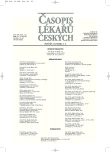Somatostatin Analogues in the Treatment of Carcinoid
Authors:
Markéta Bednaříková 1; D. Valík 2; R. Vyzula 1
Authors‘ workplace:
Klinika komplexní onkologické péče, Masarykův onkologický ústav, Brno
1; Oddělení laboratorní medicíny, Masarykův onkologický ústav, Brno
2
Published in:
Čas. Lék. čes. 2008; 147: 233-235
Category:
Case Report
Overview
The patient – born in 1960, was first diagnosed in 1981 as having malignant carcinoid of the right lung. The disease relapsed in 2002 in a form of distant dissemination. According to tumor histology – atypical carcinoid – this patient was initially treated with palliative systemic chemotherapy, specifically with cisplatin and etoposid. His disease stabilized after administration of 4 cycles of chemotherapy. The treatment was accompanied by protracted toxicity with marked alteration of his general conditions after the 4th cycle. Upon request of his relatives, the patient was referred to Masaryk Memorial Cancer Institute to receive supportive care. His general conditions then stabilized but intermittent episodic abdominal discomfort with occasional vomiting persisted. Due to positive octreoscan, the patient was given somatostatin analogues with a very good and long-term clinical effect. The symptoms disappeared, except a persisting ocular disorder due to periorbital infiltration. The patient state improved allowing further outpatient care. When somatostatin analogues were discontinued, serum chromogranin A rose rapidly and was accompanied by new appearance of symptoms. After re-administering somatostatin analogues the symptoms disappeared and the concentration of serum chromogranin A decreased. The patient has been still (with two 5,5 years interruptions) treated with somatostatin analogues with very good tolerance and clinical effect – at present there are no symptoms of the disease and, according to imaging methods, long-term stabilization continues. This case study illustrates the necessity of cautious and individual approach to the choice of treatment strategy in patients with malignant carcinoid.
Key words:
carcinoid, somatostatin analogues, chromogranin, octreotid, lanreotid.
Sources
1. Rindi, G.: Classification of neuroendocrine tumours. In: Caplin, M., Kvols, L. et al.: Handbook of Neuroendocrine Tumours. Bristol, BioScientifica Ltd, 2006, s. 37–52.
2. Rešl, M. et al.: Proliferační aktivita plicních karcinoidů, Čes.-slov. Patol., 2000, 36, s. 32–34.
3. Oberg, K. et al.: Chemotherapy and biotherapy in the treatment of neuroendocrine tumors. Ann. Oncol., 2001, 12, s. 1383–1391.
4. Campana, D. et al.: Chromogranin A: Is It a Useful Marker of neuroendocrine Tumors? J. Clin. Oncol., 2007, 25, s. 1967–1973.
Labels
Addictology Allergology and clinical immunology Angiology Audiology Clinical biochemistry Dermatology & STDs Paediatric gastroenterology Paediatric surgery Paediatric cardiology Paediatric neurology Paediatric ENT Paediatric psychiatry Paediatric rheumatology Diabetology Pharmacy Vascular surgery Pain management Dental HygienistArticle was published in
Journal of Czech Physicians

Most read in this issue
- Risk Factors of Atelectasis Following Pulmonary Lobectomy
- Somatostatin Analogues in the Treatment of Carcinoid
- Sacral Nerve Stimulation in the Treatment of Anal Incontinence
- Peripheral Nerve Injury and the Degree of Motor Involvement in Parkinson’s Disease: A Correlation Study
